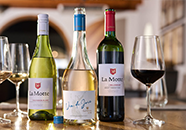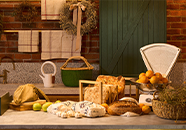
On 6 April 1652 Commander Jan van Riebeeck landed three ships in the today Cape Town, to form a half-way station on the VOC’s trading route between the Netherlands and the East Indies. The main reason for the half-way stop was to provide fresh provisions – especially fruit and vegetables – to the fleets. Soon, a hospital was also erected to take care of sailors suffering from scurvy and again, fresh produce was important.
With fertile soil and a friendly climate, the gardening efforts were very successful – one of Van Riebeeck’s 1654 diary inscription even notes that the fleets would never be able to use all of the fruit and vegetables available from the Company’s garden!
A few years later when the French Huguenots were established in the Drakenstein and Oliphantshoek (today, Franschhoek) Valleys, many fruit orchards were established. Without refrigerating facilities fruit with a longer shelf life such as Saffron pears were saved in a cool, dry place such as the attic, but otherwise when not consumed fresh, fruit was poached, dried and canned.
The delicious produce from the Wineland’s orchards made its way to the tables of the Cape in a variety of forms to be served with meat roasts or as dessert with custard or cream. This custom to serve fruit with a savoury main course today still makes out an important and unique part of Cape Winelands Cuisine – dried and poached fruit, pickles and sambals add the classic sweet-sour taste profile to many traditional savoury dishes.
Summer fruit such as peaches, pears, plums, figs and grapes were often used in the cooking of jam, preserves and jelly. As documented in the diary of Hildagonda Duckitt on a family visit to Klapmuts in the late 1800’s, the custom was to serve preserves with afternoon coffee – usually in a pretty bowl with small silver forks.
And then of course, fruit was popular with the housewives of the Cape for its use in pastry. Fruit tarts were baked in old-fashioned tart tins on an outside or open fire by stacking coal below and on top of the tins.
Following the custom of old Cape hospitality where the man of the house often served some sweet wine (called a soet sopie) with tea, cellarmaster Edmund Terblanche suggests serving the latest release of the La Motte Straw Wine with your fruit-inspired tarts and pastries such as the delicious Plum and frangipane tart (see below) from our Cape Winelands Cuisine cookbook, page 237.
Choose from the wonderful selection of summer fruit available to make your version of the below Plum and frangipane tart and surprise guests by serving a well-chilled glass of sweet wine with it!
Plum and frangipane tart recipe

Plum and frangipane tart
Serves 10
Ingredients
¼ quantity flaky pastry (see recipe at the end)
Method
Preheat the oven to 200 °C (400 °F)
Roll out the pastry on a floured surface to about 4 mm thick. Cut out 10 cm diameter rounds, place onto a buttered baking tray and bake until golden brown.
Place another backing tray on top of the rounds after they are removed from the oven and press down to flatten the pastry. Place a weight on top and return to the oven for a further 4 minutes. Leave to cool.
GLAZE
Ingredients
2 Tbsp (30 ml) brandy
2 Tbsp (30 ml) honey
2 Tbsp (30 ml) sugar
2 Tbsp (30ml) orange juice
Method
Place all the ingredients in a saucepan and cook until it has a syrupy consistency. Keep warm.
FRANGIPANE
Ingredients
2 cups (500 ml) butter
2 cups (500 ml) sugar
8 eggs, whisked
2 Tbsp (30 ml) cake flour, sifted
2½ cups (625 ml) ground almonds
Method
Beat the butter and sugar together until light and airy. Add eggs, one by one, while mixing slowly. Add the flour and almonds and refrigerate for 2 hours before using.
TO ASSEMBLE
Ingredients
12-15 ripe plums, pitted, halved and sliced 1 mm thick
Icing sugar for dusting
Method
Preheat the oven 220 °C (425 °F)
Spread the frangipane on the pastry discs – about 3 mm thick. Arrange the overlapping slices of the plums on the frangipane, all the way around until the pastry is evenly covered.
Dust with the icing sugar and place in the oven for 8-12 minutes or until the frangipane puffs up and is light brown in colour.
Lightly brush the top with the glaze and serve with a dollop of cream or your favourite ice cream (honey ice cream works well).
Flaky Pastry Recipe
Ingredients
2 cups (500 ml) cake flour
1 tsp (5 ml) salt
250 g cold butter
150 ml cold water
Method
Sift the flour and salt together in a mixing bowl.
Roughly break the butter into the flour and rub it in a little. There should still be bits of butter visible.
Add two-thirds of the water and form a rough dough. Add more water if needed.
Wrap the dough in plastic wrap and rest in the refrigerator for 1 hour.
Roll out the dough on a lightly floured surface, in one direction only and until it forms a rectangle about three times long as it is wide. Try and keep the edges of the pastry as straight as possible. The dough should still have long butter streaks visible.
Fold the top third of the pastry downwards and the bottom third over that. Turn the pastry 90 degrees and roll out to three times its length. Repeat the rolling process twice more, allowing the dough to rest in the refrigerator for 1 hour each time. Rest for 1 hour before using.












